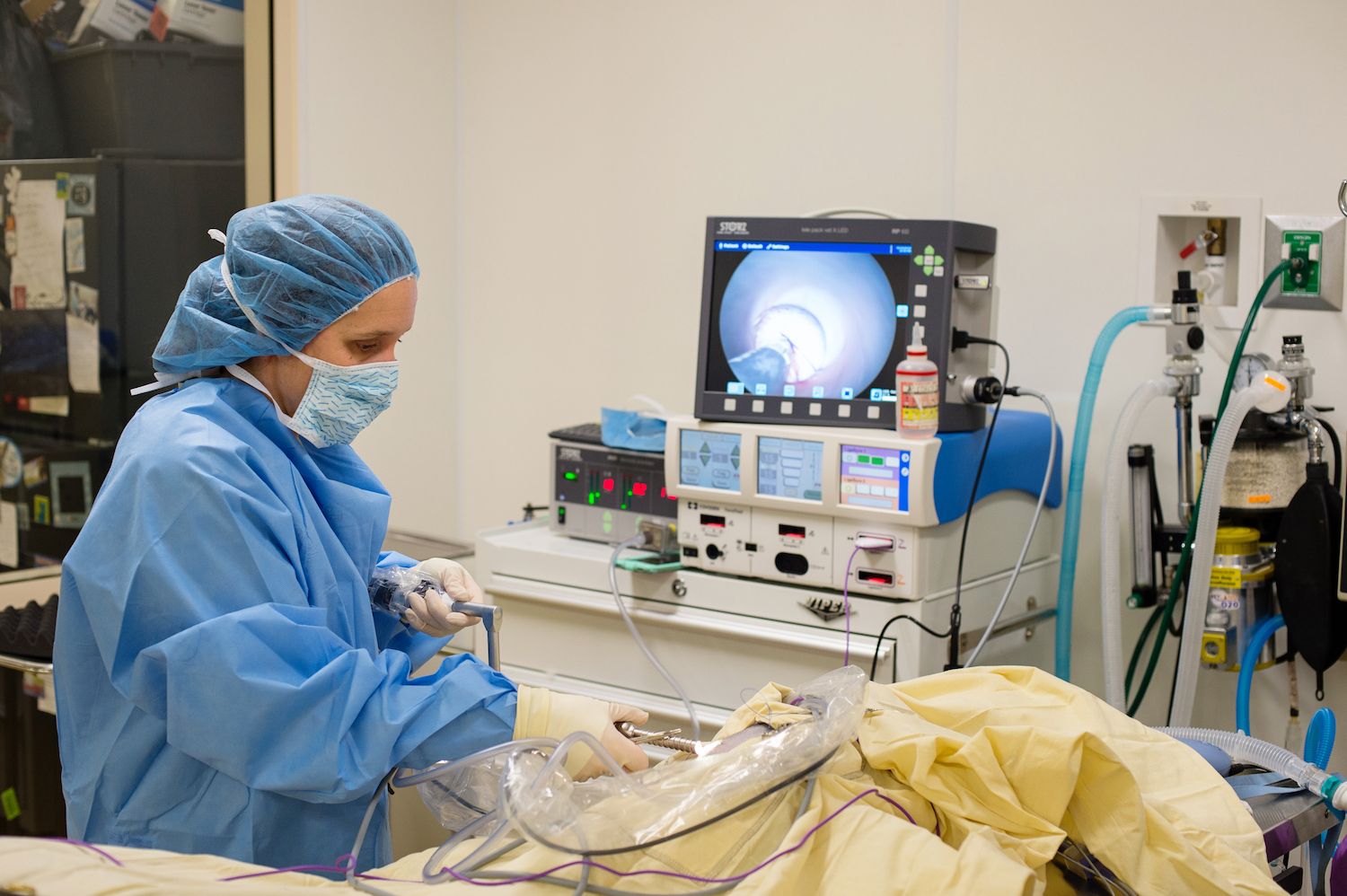Laparoscopic Spay
Who: Come one, come all (almost)
Our doctors would prefer to perform laparoscopic ovariectomy for every female patient requiring a reproductive sterilization (spay). For some patients, we really want to perform the spay procedure this way which would include our older, bigger, deep-chested, overweight dogs. These particular individuals are far more challenging than the younger, smaller, in-shape dogs and therefore are more complicated and pose higher risks to the patient. Almost all of these higher risk factors are eliminated with a laparoscopic approach. For all of the reasons outlined below, everybody else should be spayed in this way as well to decrease pain and to improve outcomes except patients with reproductive abnormalities. Some of these abnormalities are pyometra (or hydrometra or mucometra), cancers, large ovarian cysts.
What: Is a lap spay even a spay?
Laparoscopy is a type of surgical procedure involving very small incisions made into the body allowing for the passage of small cameras and high-tech operating equipment. One to three incisions are made into the abdomen approximately 1/3 inch in length instead of a single incision of approximately 3 inches. Instrumentation allows for up-close visualization of the ovaries and uterus greatly enabling an extremely safe method of ovarian removal. The desired tissue is removed via a high-tech blood vessel sealing and cutting device resulting in very little blood loss and trauma to the patient. In a traditional spay, this same tissue must be torn or ripped from its attachment to the body wall which results in the bulk of the pain associated with the spay procedure. The surgical sites are double checked for full removal of the ovaries and successful blood vessel sealing and the original hole(s) in the body wall are then sutured closed. The vast majority of lap spays performed at Alicia Pet Care Center will be performed through one abdominal incision.
Conventional spays in the U.S. have traditionally been performed through an open abdominal incision and involve removing both ovaries and the entire uterus. In Europe, almost all spays have involved only removing the ovaries during this same time. It’s not clear why this is the case but multiple studies have shown that there is no real benefit in removing the uterus during a spay and there are no real downsides to leaving it in place. The Euro way is the procedure performed during a lap spay which technically is an ovariectomy. So, yes, we should still call it a spay even though it is a tiny bit different.
Where: Alicia Pet Care Center…where else?!
When your pet has surgery at APCC, they are receiving a service package that is the result of many hours of training and experience and a collaborative effort to provide the most comprehensive and compassionate approach to surgical procedures. Our doctor team has had many meetings to specifically design the best combination of medications, anesthesia and surgical approaches for all of our patients. We have made sure that patient safety and support is the highest priority for our team and you can feel comfortable that your pet will receive a gentle and caring approach with the most up-to-date equipment and process possible. Plus, we are a cohesive team with a positive attitude that loves where we work, and we are one of the few progressive animal hospitals around that is not owned by a large corporation. Bottom line: we have the smarts, the tools, the heart and the team that is our perfect blend of awesome!
Dr.Ashbran performing a Laparoscopic Spay
When: Well…it’s complicated.
The question here will have to stay unanswered because it’s no longer as simple as “everyone gets spayed at 6 months of age.” New and ongoing research has revealed potential negative consequences to spaying too early; on the other hand, we have known for a long time that allowing pets to go through multiple heat cycles increases their risk of cancer. So, your pet should have the timing of their spay considered in relation to their specific risk factors related to their breed and the current knowledge to protect their overall health. A consultation on the specific timing of the spay for your individual pet should take place prior to scheduling a procedure.
Why: Let’s count the reasons…
So, we are going to assume that our clients already know that they should at least be considering removing their pet’s reproductive organs for the following reasons: decreasing pet overpopulation by avoiding an unplanned pregnancy, decreasing behavior disorders driven by hormones, and reducing cancer risks. But why spay your pet with a laparoscopic approach by the team at APCC? Well, because it’s safer, less painful and these patients heal significantly faster than a traditional spay.
Read our Laparoscopic spay reviews!
Alicia Pet Care is not my home vet but I took my pup here specifically for a laparoscopic spay because they are one of the few places nearby that do it. From our initial consultation with Dr. Cortright, my husband and I felt very comfortable moving forward with the surgery for our pup. The surgery went very smoothly and she recovered quickly with no issues whatsoever. I appreciated their follow-up the day after surgery as well.
Picked Alicia Pet Care because we wanted a laparoscopic spay for our goldendoodle in 2021. Drove down from Pasadena. It was a positive experience with quick recovery. We weren’t able to go in however so couldn’t say much about the office staff. Now we are back to spay our second puppy and went for pre-op visit. SO impressed by the whole experience. The front office staff, the techs and the doctor were so good with our pup and so attentive to all my questions. Felt like they went above and beyond in their care. Wish it was closer as we’d make them our regular vet! Love the way our pups are treated.
We brought our dog Luna all the way from Los Angeles for her laparoscopic spay at APCC. Before choosing APCC we researched every vet within 100 miles who performs this minimally invasive procedure. Some vets do the procedure for 4 times the cost. Others do it with no preliminary bloodwork or exam. APCC did a thorough preliminary exam, bloodwork and an ultrasound to make sure Luna was ready for her spay. On the day of the procedure they took fantastic care of her. She had a tiny incision and they sent her home with everything she needed – meds, collar and instructions for healing. They followed up by phone over the next few days to make sure she was well. They were caring, thorough and on time for every visit. And, incredibly enough, they were the least expensive clinic offering this option. Luna had virtually no pain and was bounding around in a couple of days. We can’t recommend APCC highly enough to our fellow animal lovers.
Contact Us
Call
(949) 768-1313
Fax
(949) 768-5759
Address
25800 Jeronimo Road., Suite 100
Mission Viejo, CA 92691
Let’s Get Social



